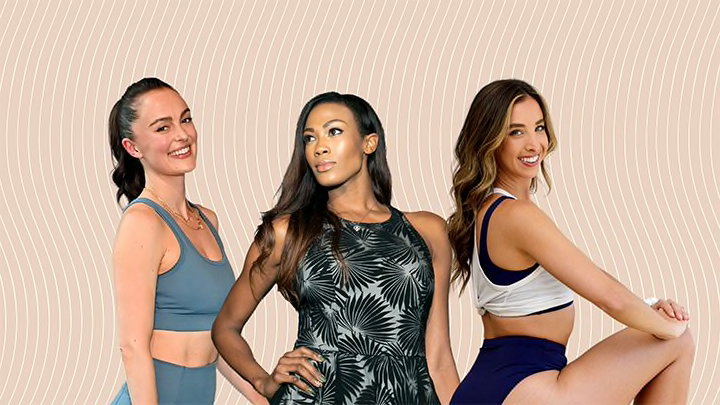How 3 Digital Fitness Instructors Find Joy in Movement

Over the past several years, the digital fitness landscape has grown immensely. The shift from in-person instruction to online and on-demand classes was accelerated by the pandemic. Even still, digital fitness instruction started years before that.
California-based instructor Katie Austin, for example, began teaching digital classes on YouTube a decade ago. But even then, while posting fitness content on social media platforms was relatively novel, at-home workouts were not. Austin’s mom, Denise Austin, started teaching fitness classes via DVD and VHS tapes back in the 1980s.
At-home fitness isn’t anything new but the intersection of digital content creation and fitness has created a new landscape, where on-demand fitness has had the chance to thrive.
In fitness, as in everything else, there are trends and there are mainstays. Digital fitness has amplified the trendy aspects of fitness, but not all of the current fixations are fleeting.
Recently, SI Swimsuit caught up with some of the fitness instructors who are leading the charge in the digital space and in-person instruction: Austin, the creator of the Katie Austin App; Megan Roup, the founder of The Sculpt Society; and Kim Glass, former Olympic volleyball player and current certified trainer. They talked all things digital instruction, its peak during the pandemic and the state of it now, the future of the fitness industry and creating fitness content that is sustainable. They all had unique perspectives, but each returned to the same themes: finding joy in fitness, creating content for every stage and identifying “trends” that are worth your time.
Finding a fitness routine that you enjoy
It can be hard to drown out the noise from social media, as various content creators preach running every day while others suggest lifting weights or taking reformer Pilates classes.
The fact is that fitness is personal. According to Austin, fitness consists of three parts: weight training and resistance, cardiovascular health and stretching. But the way that people choose to satisfy each is bound to differ.
The Katie Austin App boasts hundreds of on-demand classes ranging from HIIT to stretching that correspond to each part. Hitting each during your weekly routine—just as Austin tries to do—will ensure that you don’t “plateau,” while at the same time improving your physical health. In other words, it’s possible to find ways to move that both satisfy those three aspects and satisfy you.
For a long time, even Roup didn’t understand that. Craving movement in her 20s, she leaned into trendy routines, like hour-long stints on the treadmill. But it wasn’t enjoyable. She realized that she was listening too closely to the voices that told her that “this is what I’m supposed to be doing,” she says.
Roup feels the same way about weightlifting now that she felt about the treadmill then. IWhile it’s “a great way to work out,” she says, it’s not her preference. “If I tried to force myself to do it once a week … It would be hard for me to stick to.”
Since these routines don’t resonate with her, she assumes that they don’t resonate with others, too, so she offers alternatives. She wants subscribers to understand that finding “a modality that you look forward to, that you enjoy” is what matters.
Austin has a similar mentality. “I really go off [of] what works for me,” she explains. Like Roup, Austin has fallen into fitness routines in the past that didn’t really suit her. “I have been in different phases of my life where I only weight train or I only run,” she says. But through trial and error, she has found that diversifying her workout routine works best.
When it comes to fitness “sustainability or longevity”—or, in other words, creating routines that you enjoy enough to stick with—“switch[ing] up the workouts” is key, Austin states.
Glass would argue that any movement is better than none. Working as a trainer for the past decade has taught her that working out can be daunting. The routines she shares on her Instagram are meant to make it less so. But her biggest takeaway is this: “Find positive ways to move that makes [you] feel good.”
Fitness for every stage
Last month Austin got married. Earlier this year, she released a bridal fitness program, dedicated to helping her followers (and herself) feel their best when walking down the aisle.
Austin wants to provide quality content that conforms to her followers’ schedules at the same time as it responds to every stage of life. Her next life step is likely having kids. When that happens, she plans to release prenatal and postpartum programs.
Roup, too, creates content that responds to her followers’ needs while simultaneously “each stage of my life,” she explains. When pregnant with her first child in 2021, she found herself “frustrated with the lack of education” around pregnancy. Thus, the TSS Mama Program was born, and Roup started sharing everything from workout routines to pelvic floor exercises—important topics very few people were talking about.
But postpartum content is about more than just regaining strength. It’s about fitness routines that fit into a busy new schedule. She always returns to this question: “How can I set up really busy women for success and make it easier for them to show up each day to work out?” she says.
Currently eight months pregnant with twins, prenatal and postpartum content is top of mind for Glass. Understandably, her own movement routine has shifted over the past several months, and it will likely look different in future.
Glass continues returning to the idea of “authenticity.” Her fitness content has always been a reflection of her own personal journey, and she intends to continue that as she enters this next phase of life, benefiting mothers navigating the same chapter.
Building a community
For each instructor, fostering community is key.
Glass made a conscious effort to do just that following the pandemic. While she loves “motivating everyone,” she geared her digital platform toward women in particular. “I really wanted it to be more of a community [of women],” she says.
Roup had the same thing in mind when she founded The Sculpt Society. When working out at Crunch Fitness in her 20s, she found herself craving community. Now, when she’s teaching a dance cardio class and “showing people how [fitness] can actually be really fun,” she says she's actively building the “community I always needed.”
The three women all have a passion for in-person instruction, too. But there’s an understanding among digital fitness instructors that you can have a much broader reach on virtual platforms.
“Digital fitness is amazing because you can connect with so many more people,” Austin says. But it’s not simply about the interaction between instructors and followers—it’s about the interaction within the community. She is happy to give her followers the chance to “talk to each other from across the country.”

